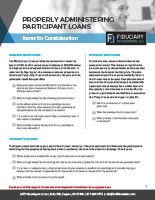
The Story
Eastern Pine has a 401(k) plan. In 2010, a new CFO was hired. As part of her duties, she was reviewing the retirement plan. She noticed some oddities about the participant loans. It looked to her like loans were going out but repayments were not being started up in payroll for everyone. She hired an outside consultant to audit the plan loans who determined that every loan audited had some problem associated with it.
How was the issue corrected?
The board of Eastern Pine requested that the plan be corrected. The recommendation was made and accepted to submit the plan to the IRS to obtain guidance and bring the plan’s loans into compliance.
The IRS assigned an agent to the case once it received the submission. The agent and the consultant discussed options. The IRS required that all errors be corrected. In Eastern Pine’s case, the loans went back more than 10 years and records no longer existed. After much discussion, it was agreed that all loans currently outstanding would be taxed to participants based on the current outstanding balances. All loans paid off in the past or distributed when an employee left would be allowed to stand unchallenged.
In this case, about $190,000 of loan balances were made taxable to participants in 2012. The plan was subsequently amended to allow only 1 loan at a time. No refinancing option is available in the plan. Loans cannot exceed 5 years in term.
How did they ensure this wouldn’t happen again?
In this scenario, the participant in Eastern Pine paid taxes on $190,000 of loan balances that were defaulted as a result of the mistake. As you can imagine, most participants with loans were not happy. The board discussed the issue and resolved this could never happen again. The decision was taken to outsource the plan’s loan administration to Fiduciary Outsourcing.

The Mistake
Participant loans are probably the area where mistakes occur most often.
Here’s just a few of the things that can go wrong with a participant loan:
- Loans are issued for improper amounts. The IRS requires that loans be for not more than $50,000 adjusted for the highest loan balance in the last 12 months for the applicable participant, or 50% of the vested account balance, whichever is less. Many plan documents impose a minimum loan amount.
- They are issued using an interest rate that doesn’t match the plan document. The amount of the loan interest may be specified in the plan document or in the plan’s loan policy. If the plan documents say use the prime rate in effect on the date of the loan plus 1%, that means the loans must be issued at that interest rate.
- Loan repayments are started too early or too late. Each loan requires certain documentation to be signed off on by the plan participant. There’s a promissory note and an amortization or repayment schedule. Contained in these two documents is the date the loan repayments are to start. Usually these documents also indicate when the loan repayments will end, but only if the repayments are made exactly as indicated on the schedule. It is possible for a participant to pre-pay a loan or be unpaid for a full pay period thereby causing the last repayment date to be adjusted. Make sure you enter the necessary information into your payroll system to start and stop the loans properly once you obtain a copy of the promissory note and amortization schedule.
- Loan repayments are stopped without proper cause. Most loan policies require loans to be repaid through payroll deduction unless the employee terminates employment. However, Sandra comes into your office and tells you her husband was just diagnosed with cancer so she’d really like to stop making loan repayments. Unfortunately, she signed a promissory note in which she agreed that repayments would be taken out of her paycheck until she terminated employment or the loan was paid off. You can’t just stop her payments because of her husband’s medical issues. Trying to be helpful to your staff will cause your retirement plan to have problems.
- Loans are taken for too long a repayment period. Most loans must be repaid in no more than 5 years. Loans for the purchase of a participant’s primary residence can be for a longer term.
- Loan repayments aren’t made in sufficient amounts. Again, refer to the promissory note and amortization schedule for the particular loan. They will indicate the minimum payment that must be made and the frequency for making that payment. Just like the participant can’t ask to stop loan repayments, they also can’t ask to have a lower amount taken out of their paychecks.
If you can think it up, it’s probably been done, frequently, with regard to getting a participant loan wrong.

What Happens
If the loans aren’t administered properly, the outstanding balance of the loan becomes taxable to the participant. Participants tend to get distressed when they face a tax consequence for a loan error, especially if they aren’t the responsible party of the error.
IRS Revenue Procedure 2013-12 provides guidance on how to fix the different types of loan errors. If the errors are fixed in accordance with this Revenue Procedure, as part of the process, you can apply to the IRS to ask that the participants not have any tax consequences as a result of the error.
Imagine that Jerry requested a loan four months ago. He asked for $20,000 to be repaid over 5 years. He signed all of the promissory note and the check was promptly issued to him. You were emailed a copy of the promissory note and repayment schedule. However, that was the day when the email server crashed and you didn’t receive the email. Jerry just looked at his pay stub this morning and realized there was no loan repayment taken out. He emailed you to ask what was going on. What do you do?
Under the IRS Revenue Procedure, the answer is to fix the loan by making a payment to the plan of the principal that would have been due and the interest that has accrued. Now Jerry, he should certainly have been paying the principal and part of the interest due for the last four months. However, if you took all three months of payments out of his next paycheck, he’d be one very unhappy employee. If, on the other hand, you do nothing, his loan will become taxable to him as he has likely missed too many payments. Should the company have to pay back the missed payments due to the error?
Whatever way Jerry’s loan problem gets resolved, all loan corrections are required to be submitted to IRS under their Voluntary Correction Program. So, the IRS gets to sign off that the error was properly fixed. There is a user fee based on the number of loans that require correction to obtain that needed IRS sign off.
If you have made loan errors, find an expert in plan corrections and ask them for assistance to correct your plan loans. There rules differ based on the different types of errors, so it’s best to ask a professional for assistance.
Avoid it
The best way to avoid making loan mistakes is to have your payroll company talk to your plan’s recordkeeper. That way the recordkeeper can communicate the needed information to the payroll company and vice versa.
If you must oversee loans yourself, keep in mind that they are rather complicated so the best place to start is to read the plan document or plan’s loan policy to understand the rules.
You then want to create procedures for each of the following:
- What happens when someone asks for a loan?
- Who reviewed the loan request to ensure the amount, interest rate and term are acceptable according to the plan document?
- Has the participant signed a repayment agreement before they receive their loan check?
- How do you get notified that there is a new loan to be set up in payroll?
- What process will you use to start up the loan repayments?
- How will you ensure the loan repayments are started on time?
- When will loan repayments cease?
- How will you know when the loan is fully repaid so you stop making payments?
Loans get even more complicated when dealing with:
- Leaves of absence
- Seasonal employees or employees who don’t work all 12 months such as teachers
- Rehired participants
Ask your service provider team exactly what they do to support the plan loans. Understand which portion of loan management remains with you. Create procedures to oversee the loans. Check with your service provider team to see if they can help you improve your procedures to ensure as few problems in the future as is possible.

How We Help
You have the ability to outsource your responsibilities as the Plan Administrator. As such, you can outsource the responsibility to set up loans in your payroll system. You can outsource the responsibility to transmit loan repayments to the recordkeeper. You can outsource the ability to stop loan repayments on the payroll system to us. We would then be the responsible fiduciary for loan administration.

Checklist

The Story
Eastern Pine has a 401(k) plan. In 2010, a new CFO was hired. As part of her duties, she was reviewing the retirement plan. She noticed some oddities about the participant loans. It looked to her like loans were going out but repayments were not being started up in payroll for everyone. She hired an outside consultant to audit the plan loans who determined that every loan audited had some problem associated with it.
How was the issue corrected?
The board of Eastern Pine requested that the plan be corrected. The recommendation was made and accepted to submit the plan to the IRS to obtain guidance and bring the plan’s loans into compliance.
The IRS assigned an agent to the case once it received the submission. The agent and the consultant discussed options. The IRS required that all errors be corrected. In Eastern Pine’s case, the loans went back more than 10 years and records no longer existed. After much discussion, it was agreed that all loans currently outstanding would be taxed to participants based on the current outstanding balances. All loans paid off in the past or distributed when an employee left would be allowed to stand unchallenged.
In this case, about $190,000 of loan balances were made taxable to participants in 2012. The plan was subsequently amended to allow only 1 loan at a time. No refinancing option is available in the plan. Loans cannot exceed 5 years in term.
How did they ensure this wouldn’t happen again?
In this scenario, the participant in Eastern Pine paid taxes on $190,000 of loan balances that were defaulted as a result of the mistake. As you can imagine, most participants with loans were not happy. The board discussed the issue and resolved this could never happen again. The decision was taken to outsource the plan’s loan administration to Fiduciary Outsourcing.

The Mistake
Participant loans are probably the area where mistakes occur most often.
Here’s just a few of the things that can go wrong with a participant loan:
- Loans are issued for improper amounts. The IRS requires that loans be for not more than $50,000 adjusted for the highest loan balance in the last 12 months for the applicable participant, or 50% of the vested account balance, whichever is less. Many plan documents impose a minimum loan amount.
- They are issued using an interest rate that doesn’t match the plan document. The amount of the loan interest may be specified in the plan document or in the plan’s loan policy. If the plan documents say use the prime rate in effect on the date of the loan plus 1%, that means the loans must be issued at that interest rate.
- Loan repayments are started too early or too late. Each loan requires certain documentation to be signed off on by the plan participant. There’s a promissory note and an amortization or repayment schedule. Contained in these two documents is the date the loan repayments are to start. Usually these documents also indicate when the loan repayments will end, but only if the repayments are made exactly as indicated on the schedule. It is possible for a participant to pre-pay a loan or be unpaid for a full pay period thereby causing the last repayment date to be adjusted. Make sure you enter the necessary information into your payroll system to start and stop the loans properly once you obtain a copy of the promissory note and amortization schedule.
- Loan repayments are stopped without proper cause. Most loan policies require loans to be repaid through payroll deduction unless the employee terminates employment. However, Sandra comes into your office and tells you her husband was just diagnosed with cancer so she’d really like to stop making loan repayments. Unfortunately, she signed a promissory note in which she agreed that repayments would be taken out of her paycheck until she terminated employment or the loan was paid off. You can’t just stop her payments because of her husband’s medical issues. Trying to be helpful to your staff will cause your retirement plan to have problems.
- Loans are taken for too long a repayment period. Most loans must be repaid in no more than 5 years. Loans for the purchase of a participant’s primary residence can be for a longer term.
- Loan repayments aren’t made in sufficient amounts. Again, refer to the promissory note and amortization schedule for the particular loan. They will indicate the minimum payment that must be made and the frequency for making that payment. Just like the participant can’t ask to stop loan repayments, they also can’t ask to have a lower amount taken out of their paychecks.
If you can think it up, it’s probably been done, frequently, with regard to getting a participant loan wrong.

What Happens
If the loans aren’t administered properly, the outstanding balance of the loan becomes taxable to the participant. Participants tend to get distressed when they face a tax consequence for a loan error, especially if they aren’t the responsible party of the error.
IRS Revenue Procedure 2013-12 provides guidance on how to fix the different types of loan errors. If the errors are fixed in accordance with this Revenue Procedure, as part of the process, you can apply to the IRS to ask that the participants not have any tax consequences as a result of the error.
Imagine that Jerry requested a loan four months ago. He asked for $20,000 to be repaid over 5 years. He signed all of the promissory note and the check was promptly issued to him. You were emailed a copy of the promissory note and repayment schedule. However, that was the day when the email server crashed and you didn’t receive the email. Jerry just looked at his pay stub this morning and realized there was no loan repayment taken out. He emailed you to ask what was going on. What do you do?
Under the IRS Revenue Procedure, the answer is to fix the loan by making a payment to the plan of the principal that would have been due and the interest that has accrued. Now Jerry, he should certainly have been paying the principal and part of the interest due for the last four months. However, if you took all three months of payments out of his next paycheck, he’d be one very unhappy employee. If, on the other hand, you do nothing, his loan will become taxable to him as he has likely missed too many payments. Should the company have to pay back the missed payments due to the error?
Whatever way Jerry’s loan problem gets resolved, all loan corrections are required to be submitted to IRS under their Voluntary Correction Program. So, the IRS gets to sign off that the error was properly fixed. There is a user fee based on the number of loans that require correction to obtain that needed IRS sign off.
If you have made loan errors, find an expert in plan corrections and ask them for assistance to correct your plan loans. There rules differ based on the different types of errors, so it’s best to ask a professional for assistance.
Avoid it
The best way to avoid making loan mistakes is to have your payroll company talk to your plan’s recordkeeper. That way the recordkeeper can communicate the needed information to the payroll company and vice versa.
If you must oversee loans yourself, keep in mind that they are rather complicated so the best place to start is to read the plan document or plan’s loan policy to understand the rules.
You then want to create procedures for each of the following:
- What happens when someone asks for a loan?
- Who reviewed the loan request to ensure the amount, interest rate and term are acceptable according to the plan document?
- Has the participant signed a repayment agreement before they receive their loan check?
- How do you get notified that there is a new loan to be set up in payroll?
- What process will you use to start up the loan repayments?
- How will you ensure the loan repayments are started on time?
- When will loan repayments cease?
- How will you know when the loan is fully repaid so you stop making payments?
Loans get even more complicated when dealing with:
- Leaves of absence
- Seasonal employees or employees who don’t work all 12 months such as teachers
- Rehired participants
Ask your service provider team exactly what they do to support the plan loans. Understand which portion of loan management remains with you. Create procedures to oversee the loans. Check with your service provider team to see if they can help you improve your procedures to ensure as few problems in the future as is possible.

How We Help
You have the ability to outsource your responsibilities as the Plan Administrator. As such, you can outsource the responsibility to set up loans in your payroll system. You can outsource the responsibility to transmit loan repayments to the recordkeeper. You can outsource the ability to stop loan repayments on the payroll system to us. We would then be the responsible fiduciary for loan administration.

Checklist

